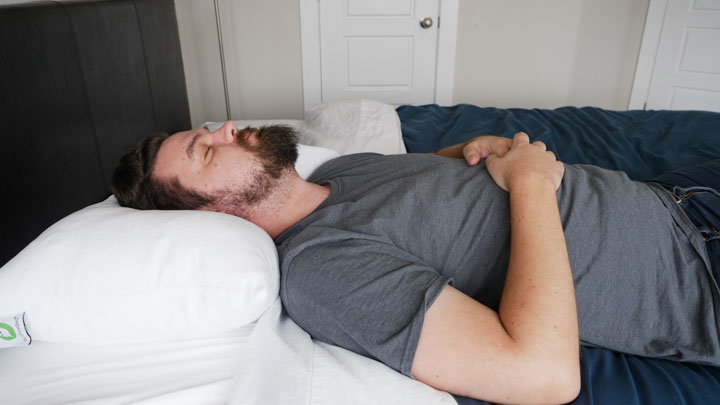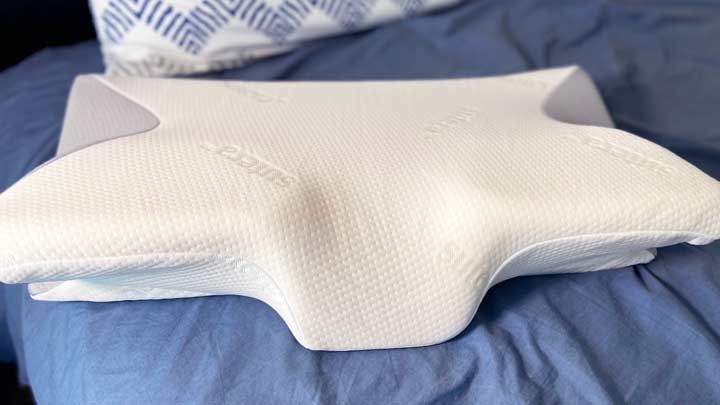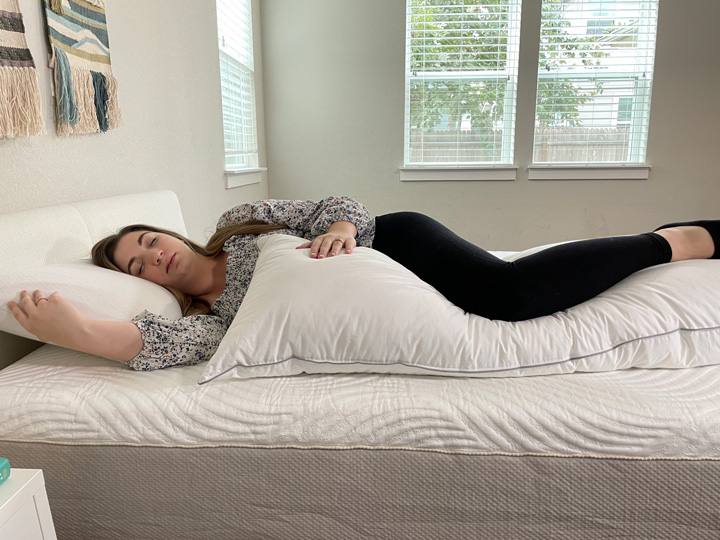Just like your mattress, your pillow is an important tool for giving you a good night’s sleep and restful relaxation. As it turns out, there can be too much a good thing when it comes to the amount of pillows you have. So, how many pillows should you sleep with to give you the most comfortable and healthy sleep environment?
It should really only take one good pillow under your head to give you a proper night’s sleep. Keep reading to learn why it’s best to sleep with one pillow and how to choose the right pillow for you.
Why Should We Opt for One Pillow?
Decorating your bed with a multitude of pillows may be aesthetically pleasing, but actually sleeping with too many pillows on your bed can be a harmful thing. Sleep experts recommend only sleeping with one pillow underneath your head. Additional pillows may be used in other places, like between your legs or arms, to promote healthy sleep and support.
The goal of the pillow you lay on is to provide proper spinal alignment, meaning the head, neck and spine all align in a straight line. This is also referred to as neutral alignment. If your head and neck are either craned upward or drooping downward, it can lead to neck and upper back pain.

Some people stack multiple flimsy or thin pillows to support their head and neck, but this method can be harmful for two reasons. First, stacking pillows usually leads to the head being propped up too high, causing neck pain. Second, thinner pillows won’t provide neutral spinal alignment or enough pressure relief to most sleepers. If this is your preferred way of sleeping, we recommend buying a new, more supportive pillow.
How To Choose the Right Pillow
Just like shopping for the right mattress, there are a few things to keep in mind when you shop for the right pillow. Remember that there is no single best pillow because everyone has different sleep preferences. Here are the main factors to consider when purchasing your next pillow:
Material
Today, pillows are more innovative than ever before. The materials a pillow is made of determine its firmness and feel. Feel can be up to preference, but some materials perform better than others for providing support, pressure relief and cooling. I’ll touch on some of the most popular pillow materials and how they perform.
- Memory foam: Memory foam pillows are durable, supportive and great for pain relief. The slow-moving material will contour around your head and neck to deliver neutral spinal alignment.
- Latex: Latex pillows are similar to memory foam, but are more responsive and bouncy. They are also incredibly durable and supportive.
- Down: Down pillows are soft and malleable and are less supportive than memory foam or latex pillows.
- Down Alternative: Down alternative pillows are similar to down pillows but are made from synthetic fibers. They are popular because of their affordability and are good for people with allergies.
- Adjustable: Adjustable pillows have additional and removable filling that you can customize to your feel and firmness preferences. They are good for any sleep position and come in a variety of styles and fillings.

Size
Pillow sizes often correlate with mattress sizes. Standard pillows are 20” by 26” and are a comfortable option for sleepers on smaller mattresses or those who do not move around in their sleep. Queen size pillows are 20” by 30” and are designed to fit across a queen size mattress. Jumbo or king size pillows are 20” by 36” and are great for sleepers on larger mattresses or those who change sleep positions.
Speciality and decorative pillows can come in a variety of sizes. You’ll find that there are a handful of orthopedic pillows that also come in unique and ergonomic shapes and sizes specifically designed to maintain sleep posture. A body pillow is usually 54” long and can vary in shape. Body pillows are especially beneficial for side sleepers to enable spinal alignment.

Pillow Lofts
Loft, also known as height, greatly impacts how comfortable a pillow feels. You want to ensure that the pillow you sleep on keeps your spine in proper neutral alignment to prevent neck and back pain. Your primary sleep position has a lot to do with the amount of loft you should look for.
If you are unsure what loft provides the best spinal alignment, consider purchasing an adjustable or dual profile pillow with customizable loft options.
Low Loft
Thinner, low-loft pillows are a great option for stomach sleepers. A pillow 3” or slightly shorter will deliver neutral alignment to lighter sleepers who don’t sink far into their pillows. Lightweight back sleepers could also receive neutral alignment from a low loft pillow.
Some stomach sleepers might not even need a pillow. We answered the question on whether or not you can sleep without a pillow here.
Medium Loft
Medium-loft pillows are usually between 3”-5” tall and are perfect for most back sleepers. Side sleepers with a smaller frame could also consider buying a medium loft pillow to provide neutral alignment.
High Loft
High-loft pillows are usually between 5”-7” tall and are typically best suited for side sleepers. Side sleepers should look for a pillow that is tall and supportive enough to keep their neck elevated comfortably all night long. Big and tall back sleepers with broad shoulders should also consider higher loft pillows to feel properly supported.
Sleeping With Multiple Pillows
There are times that sleeping with multiple pillows can improve your sleep quality. While I still recommend only using one pillow to support your head and neck, other pillows can be used elsewhere to promote spinal alignment.
How Many Pillows Should Side Sleepers Use
For side sleepers, a proper pillow should line up your ear with your shoulder and your chin with your sternum. The best pillows for side sleepers will fit snugly in the gap between your head, neck and shoulder to promote healthy sleep posture.
According to UCLA, side sleepers can maintain proper sleep posture by sleeping with a second pillow between their knees. This will prevent their upper leg from twisting the hips out of alignment with the rest of their body.

How Many Pillows Should Back Sleepers Use
Back sleeping is known to be the healthiest sleep position since it is the best for spinal alignment. The best pillows for back sleepers allow the natural curvature of the neck to gently slope into the rest of the spine. The goal with a pillow for back sleepers is to keep your chin in line with your sternum. If your chin is jutting into your chest, or pointing too far up, you do not have proper alignment. Back sleepers may want to place a second pillow under their knees to relieve lower back pain.
How Many Pillows Should Stomach Sleepers Use
Stomach sleeping is the position that poses the most risk for improper spinal alignment. Experts from the University of Rochester Medical Center recommend stomach sleepers place a second pillow under the pelvis to elevate hips, which will better keep the spine in neutral alignment. If sleeping on your stomach is the only comfortable option, the best pillow for stomach sleepers is one with a low loft to fill in the gap between your head and your mattress.
Pillows for Neck and Back Pain
Waking up with neck or back pain is common for many. In some cases, your mattress or pillow can cause neck pain and/or back pain. One study found that 15%-20% of new cases of chronic musculoskeletal pain can be attributed to poor sleep quality. The good news is that if it is your pillow causing the problem, it’s easy to make a change— once you know what to look for.
Pillows for Neck Pain
If your current pillow leaves your head wilting downward or propped up at an angle, there’s a good chance your pillow is responsible for your neck pain. Firmness and loft are two of the main factors to determine whether or not your pillow will be effective for relieving neck pain. Adjustable or malleable pillows allow sleepers to find the right firmness, loft and position that offers perfect spinal alignment. The best pillows for neck pain provide enough support to your neck and head while still having some give to deliver pressure relief.
Pillows for Back Pain
Depending on your sleep position and where your back pain is, you can determine the best way to eliminate those aches and pains. Some pillows that are great for neck pain will also work for relieving upper back pain. But for lower back pain, a second standard size pillow or body pillow will help with full body support. At the end of the day, the best pillows for back pain are the pillows that provide neutral spinal alignment in your preferred sleeping position.
The Takeaway
Your pillow should be aligning your head and neck with your spine in a straight line as you sleep. Sleep experts recommend sleeping with only one pillow under your head to maintain neutral spinal alignment. A pillow’s loft and filling material will factor into what the best pillow for you is. Depending on your sleep position, sleep experts also recommend sleeping with a body pillow or second pillow in other areas.
FAQs
Is it better to sleep with one or two pillows?
It is best to sleep with one pillow to support your head and neck. Stacking two pillows under your head can lead to improper spinal alignment and neck pain. However, you can sleep with a second pillow or body pillow to support your body and maintain sleep posture.
How many pillows are you supposed to sleep with?
Sleep experts recommend sleeping with one pillow underneath your head. Depending on your sleep position, you can use a second pillow to maintain spinal alignment.
Is it better to sleep without a pillow?
Most people should sleep with a pillow to maintain neutral spinal alignment. For back and side sleepers, sleeping without a pillow can result in neck pain or headaches. But for some stomach sleepers, it may be more comfortable to sleep without a pillow on a firm enough mattress.

